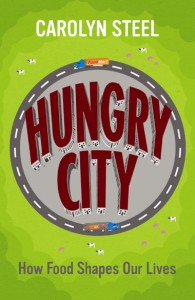Carolyn Steel, Hungry City: How Food Shapes Our Lives, Chatto & Windus: London, 2008.
Architect turned foodie, Carloyn Steel, excavates the politics of food and food supply routes, questioning the über appetite of metro zones. Steel asserts how food has shaped different urban conglomerates and reveals the histories and futures of the ‘latent bounteousness’ of cities, but also the darkside of our blind dependence on the countryside that feeds us. An extraordinary historical, political and practical reference. Steel’s vivid writing gets under the skin and into the anatomy of the city revealing the flesh, bones and alimentary canals of the cityscape.
Cities, like people, are what they eat. The effort necessary to feed them has, arguably, a greater social and physical impact on us and our planet than anything else we do – yet few of us are aware of the process. Food arrives on our plates as if by magic, and we rarely stop to wonder how it got there. But when you consider that every day for a city the size of London, enough food for 30 million meals must be produced, imported, sold, cooked, eaten and disposed of again, and that something similar must happen every day for every city on earth, it is remarkable that cities get to eat at all. Industrialisation has made feeding cities seem easy, but with food prices soaring and Peak Oil looming – to say nothing of the threat of climate change – that illusion is wearing off. With the world’s urban population set to double by 2050, we need a new urban model: one in which city and hinterland are treated as a single, organic whole. — Taken from the publisher’s blurb.
